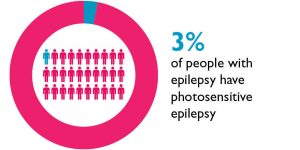Jump to the info you need:
How common is photosensitive epilepsy?
Photosensitive epilepsy is rare. Around 1 in 100 people in the UK have epilepsy. And of these people, 3 in every 100 have photosensitive epilepsy.

Most people who develop photosensitive epilepsy are aged between 7 and 19 years old. But a small number of people who develop epilepsy as adults also have photosensitive seizures.
Women are more likely to have photosensitive epilepsy than men.
If someone in your family has photosensitive epilepsy, you are more likely to have it too. And if someone in your family has juvenile myoclonic epilepsy, you are also at higher risk of having photosensitive epilepsy.
There are many types of epilepsy. Photosensitive epilepsy is most common in:
- Juvenile myoclonic epilepsy
- Childhood absence epilepsy
- West syndrome
- Lennox Gastaut syndrome
- Juvenile absence epilepsy
- Dravet syndrome
Are there tests that can show if I have photosensitive epilepsy?
Your doctor might ask you to have an electroencephalogram (EEG) test to see if you have photosensitive epilepsy. The EEG records the electrical signals from your brain on an EEG machine.
During the test, you will be asked to look at some flashing lights, to see whether your brainwave patterns change. If they do, it may mean you have photosensitive epilepsy.
What is the treatment for photosensitive epilepsy?
The most common way to treat photosensitive epilepsy is with epilepsy medicines. This is to lower the risk of having a seizure.
Photosensitive epilepsy can also be treated by avoiding photosensitive seizure triggers and making practical changes to reduce the risk of having a seizure. This can work particularly well for people who only have seizures triggered by flashing or flickering lights or patterns.
Many people find that a combination of taking epilepsy medicines and avoiding seizure triggers is the most effective way of preventing or reducing seizures.
To reduce the risk further, try to avoid other common seizure triggers such as drinking too much alcohol and not getting enough sleep.
What can trigger photosensitive seizures?
There are many types of flashing or flickering lights, or patterns that can trigger seizures. These vary from person to person. So, what triggers your seizures may not trigger someone else’s.
Below are some possible triggers:
-
Flashing lights
People with photosensitive epilepsy are affected by lights that have different flash or flicker rates from as low as 3 to as high as 60 per second. Lights that flash or flicker between 16 and 25 times a second are the most likely to trigger seizures.
Some lights, such as bicycle lights (red and white), are covered by UK law, which says that these lights must not flash at less than one or more than 4 flashes a second. Provided the lights comply with the law, they are unlikely to cause a problem.
Other lights, such as Christmas lights and strobe lights, are not covered by UK law. This means it is possible that the flash frequency of these lights could trigger a seizure.
Light bulbs which are not designed to flash are only a possible seizure trigger if they are faulty or if the wrong type of bulb is used. For example, if the wrong bulb is used with a dimmer switch, this could cause a flickering effect.
-
Online content and social media
Content shared online and on social media platforms could trigger seizures if it contains flashing imagery or has animated patterns.
This could be in videos, GIFs, or animated backgrounds used in video conferencing systems such as Zoom and Microsoft Teams. On many online and social media platforms, it’s possible to turn off the ‘auto-play’ feature for videos and GIFs.
-
Patterns
Patterns can trigger seizures.
They include:
- High contrast patterns such as black and white stripes
- Striped or patterned materials and walls
- Patterns in some television programmes, video or electronic games
- A moving escalator
-
Rotating blades
The blades of some ceiling fans can rotate at a fast speed. Looking at light through them could trigger a seizure.
Large wind turbines have blades which rotate at a rate that is unlikely to trigger a seizure. Smaller turbines can rotate at a faster rate. When these smaller turbines create a shadow and/or flicker effect with the sun, they could trigger a seizure.
-
Screens
Computer screens, phones, tablets, and interactive whiteboards are unlikely to be a seizure trigger by themselves. But, if there are flashing or flickering images, or some types of pattern on the screen, these could trigger a seizure.
Modern TV screens don’t flicker and so are also unlikely to be a seizure trigger for most people. But, if a programme shows images that flash or flicker, these could be a seizure trigger for some people.
Screen images with bright, high contrast colours can be more likely to trigger a seizure. See below for some suggestions of how to reduce the risk.
-
Sunlight
Looking directly at certain patterns caused by sunlight could be a seizure trigger for some people. Examples of these situations are:
- Sunlight through slatted blinds
- Sunlight through trees, viewed from a moving vehicle
- Sunlight reflected off moving water or off snow
- Sunlight through moving leaves
- Sunlight through railings, as you move past them
How can I reduce the risk from photosensitive seizure triggers?
It can be difficult to completely avoid things that could trigger a photosensitive seizure. If you come across something that might trigger a seizure without warning, there are some things you can do to reduce the risk:
- Cover one eye with the palm of your hand straight away
- Turn away from the possible trigger
- Don’t close your eyes (as this could cause a flicker effect)
There are also some things you can do to reduce sensitivity to triggers on computer screens, TVs and in video games, if these could be a trigger for you:
- Avoid screen time if you are feeling very stressed, tired or have not had enough sleep.
- Lower the brightness and contrast settings on screens and video games where possible.
- If indoors, try to make sure the room is well lit.
- Try to stay at least 2.5 meters (8 feet) from 20-inch TV screens and further away from large screen TVs, if possible. Your distance from the screen should be at least three times the width of TV screen.
- Consider using a small screen.
- Use a flat screen with a high refresh rate. Plasma, LCD, or TFT screens with a refresh rate of 100herz, are less likely to trigger a seizure than older TVs and computer monitors.
- Place an anti-glare filter over the screen or use a downloadable screen filter.
- Change the settings on your social media platforms so that videos and GIFs do not play automatically.
- If using video conferencing software, try not to use animated backgrounds and consider asking others to do the same.
- Try to limit the amount of time you spend using screens and take regular breaks.
Some people with photosensitive epilepsy may also benefit from wearing special glasses with dark or filtered lenses. Studies show that wearing glasses with a dark cobalt blue lens, called a ‘Z1 lens’, can help prevent photosensitive seizures.
These lenses work by reducing the total amount of light and filtering out red light, as this colour light is most likely to trigger a seizure. Glasses with Z1 lens are not suitable for use whilst driving.
How do I complain about flashing lights or triggering content?
To complain about flashing artificial lights, you can contact your local council. They will consider complaints about ‘nuisance lights’. More information on what counts as a statutory nuisance is available on the government website.
The council will consider how the lights are likely to affect the ‘average person’. They don’t include ‘unusual sensitivities’ in their assessment, so may not take into account your photosensitive epilepsy.
To complain about online seizure-triggering content, you can report the content to the relevant social media platform.
If you encounter flashing lights that are likely to affect a large number of people, we would like to hear from you. We would also like to hear if you have complained about a TV programme or online video that contains flashing images but are unhappy with the reply you have received.
In either case, you can contact our campaigns team on campaigns@epilepsy.org.uk
Got any questions?
Our expert advisors can help you with any questions you might have about photosensitive epilepsy or anything else related to living with epilepsy.
This page is currently under review and will be updated soon.


